Topological atlas of the hypothalamus in adult rhesus monkey
- PMID: 32556476
- PMCID: PMC7321918
- DOI: 10.1007/s00429-020-02093-8
Topological atlas of the hypothalamus in adult rhesus monkey
Abstract
The prosomeric model explains the embryological development of the central nervous system (CNS) shared by all vertebrates as a Bauplan. As a primary event, the early neural plate is patterned by intersecting longitudinal plates and transverse segments, forming a mosaic of progenitor units. The hypothalamus is specified by three prosomeres (hp1, hp2, and the acroterminal domain) of the secondary prosencephalon with corresponding alar and basal plate parts, which develop apart from the diencephalon. Mounting evidence suggests that progenitor units within alar and basal plate parts of hp1 and hp2 give rise to distinct hypothalamic nuclei, which preserve their relative invariant positioning (topology) in the adult brain. Nonetheless, the principles of the prosomeric model have not been applied so far to the hypothalamus of adult primates. We parcellated hypothalamic nuclei in adult rhesus monkeys (Macaca mulatta) using various stains to view architectonic boundaries. We then analyzed the topological relations of hypothalamic nuclei and adjacent hypothalamic landmarks with homology across rodent and primate species to trace the origin of adult hypothalamic nuclei to the alar or basal plate components of hp1 and hp2. We generated a novel atlas of the hypothalamus of the adult rhesus monkey with developmental ontologies for each hypothalamic nucleus. The result is a systematic reinterpretation of the adult hypothalamus whose prosomeric ontology can be used to study relationships between the hypothalamus and other regions of the CNS. Further, our atlas may serve as a tool to predict causal patterns in physiological and pathological pathways involving the hypothalamus.
Keywords: Alar plate; Basal plate; Holoprosencephaly; Prethalamus; Prosomere; Prosomeric model; Secondary prosencephalon.
Conflict of interest statement
No conflicts of interest, financial or otherwise, are declared by the authors.
Figures


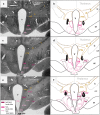
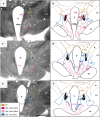
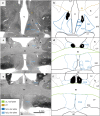

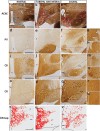
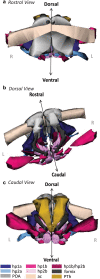

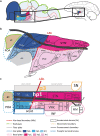
Similar articles
-
Prosomeric Hypothalamic Distribution of Tyrosine Hydroxylase Positive Cells in Adolescent Rats.Front Neuroanat. 2022 May 6;16:868345. doi: 10.3389/fnana.2022.868345. eCollection 2022. Front Neuroanat. 2022. PMID: 35601999 Free PMC article.
-
Molecular codes defining rostrocaudal domains in the embryonic mouse hypothalamus.Front Neuroanat. 2015 Apr 17;9:46. doi: 10.3389/fnana.2015.00046. eCollection 2015. Front Neuroanat. 2015. PMID: 25941476 Free PMC article.
-
Genoarchitectonics of the larval zebrafish diencephalon.J Comp Neurol. 2024 Mar;532(3):e25549. doi: 10.1002/cne.25549. Epub 2023 Nov 20. J Comp Neurol. 2024. PMID: 37983970
-
Forebrain gene expression domains and the evolving prosomeric model.Trends Neurosci. 2003 Sep;26(9):469-76. doi: 10.1016/S0166-2236(03)00234-0. Trends Neurosci. 2003. PMID: 12948657 Review.
-
Differential developmental strategies by Sonic hedgehog in thalamus and hypothalamus.J Chem Neuroanat. 2016 Sep;75(Pt A):20-7. doi: 10.1016/j.jchemneu.2015.11.008. Epub 2015 Dec 12. J Chem Neuroanat. 2016. PMID: 26686294 Review.
Cited by
-
The expression of transcription factors in the human fetal subthalamic nucleus suggests its origin from the first hypothalamic prosomere.Brain Struct Funct. 2025 Jan 20;230(2):33. doi: 10.1007/s00429-025-02893-w. Brain Struct Funct. 2025. PMID: 39831906
-
High-resolution mapping and digital atlas of subcortical regions in the macaque monkey based on matched MAP-MRI and histology.Neuroimage. 2021 Dec 15;245:118759. doi: 10.1016/j.neuroimage.2021.118759. Epub 2021 Nov 25. Neuroimage. 2021. PMID: 34838750 Free PMC article.
-
Self-tuition as an essential design feature of the brain.Philos Trans R Soc Lond B Biol Sci. 2022 Feb 14;377(1844):20200530. doi: 10.1098/rstb.2020.0530. Epub 2021 Dec 27. Philos Trans R Soc Lond B Biol Sci. 2022. PMID: 34957855 Free PMC article. Review.
-
The Spiraling Cognitive-Emotional Brain: Combinatorial, Reciprocal, and Reentrant Macro-organization.J Cogn Neurosci. 2024 Dec 1;36(12):2697-2711. doi: 10.1162/jocn_a_02146. J Cogn Neurosci. 2024. PMID: 38530327
-
Mapping the primate thalamus: historical perspective and modern approaches for defining nuclei.Brain Struct Funct. 2023 Jun;228(5):1125-1151. doi: 10.1007/s00429-022-02598-4. Epub 2023 Jan 9. Brain Struct Funct. 2023. PMID: 36622414 Free PMC article. Review.
References
MeSH terms
Grants and funding
LinkOut - more resources
Full Text Sources
Research Materials

